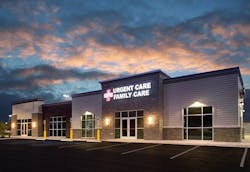Traditional primary care is struggling, but urgent care is thriving: The number of urgent care centers rose from 6,100 in 2013 to 8,774 in June 2018, and is continuing to grow in all parts of the country — especially rural and underserved areas. Patients are evolving too, seeking faster, more convenient, cost-effective medical care that addresses both acute issues and long-term medical needs. But there are challenges inherent with the traditional urgent care model — like improving the wellbeing and livelihoods of patients who are seeking quick medical fixes and who might not make a return visit. Leveraging a holistic, organization-wide quality improvement strategy across multiple facilities under CMS’ MIPS program, the Birmingham, Alabama-based American Family Care (AFC), the nation’s largest single provider of urgent care, accessible primary care and occupational medicine, successfully broadened the scope of traditional urgent care centers beyond sprains, strains and X-Rays. By employing strategies and tools to improve quality measurement and reporting, the organization, which oversees nearly 3 million patient visits per year, has expanded on the urgent care center concept and reworked it to serve communities more broadly.
Benjamin Barlow, M.D., AFC’s chief medical officer, had been scheduled to speak on Thursday, March 12, at HIMSS20, under the presentation title, “Long-Term Quality in Urgent Care Settings,” before the conference was canceled because of the coronavirus emergency. Dr. Barlow has been CMO at AFC for 21 months; he joined the organization after more than a decade of service in the U.S. Air Force and three years as a White House physician. Throughout his military career, Dr. Barlow was assigned roles of increasing responsibility, including overseas deployment in support of combat troops and a role as Emergency Department Medical Director at Langley Air Force Base — the busiest emergency department (ED) in the Air Force with 36,000 patient visits per year. During his final years in the Air Force, Barlow served as the Senior White House Physician, directly caring for Presidents Obama and Trump. A week before HIMSS20 had been scheduled to take place, Dr. Barlow spoke with Healthcare Innovation Editor-in-Chief Mark Hagland regarding the forward evolution of care delivery at AFC. Below are excerpts from that interview.
How do you explain what AFC is, to those unfamiliar with it?
We provide accessible primary care, traditional urgent care, but also in terms of community needs, via 230 clinics across 22 states. We open a clinic every two weeks. Our goal is to be at 500 in the next few years. We’re a mix of corporate clinics in Alabama, Tennessee, Florida, and Georgia, and the rest are franchise clinics, independently owned and operated, and they purchase from us. We help them to run a clinic. We think that’s the secret to our success. They care so much.
Are you still in clinical practice?
Yes, I do a lot of teaching shifts with physicians on shift, and work on quality work with nurses.
Tell me about the data analytics element in your organization’s operations?
With the new EHRs [electronic health records], and the fact that we see 3 million patients a year, we collect a massive amount of data on patients. So we’re focusing on efforts to collect and analyze data and use it to improve the care of individuals.
Is your organization involved in value-based contracting?
Yes, in all categories; we see Medicare, Medicaid, and commercially insured patients, and are involved local hospitals in a variety of different ACOs [accountable care organizations].
What have been some of the main challenges and opportunities involved in working with data?
EHRs were developed by IT professionals, sometimes not keeping the front-end physician or provider in mind. And how rapidly you get data into the systems—a lot of these systems, you can collect the data, but it will take forever to get the data to the provider, and so that will never work. So I spend a lot of time streamlining systems and processes to get the data to them.
So one emphasis has been getting the data to the physicians and other clinicians at the point of care?
That’s always a lot of work. With our EHR vendors, I set the guidelines around what we’re looking for in reports in terms of data points, and then we blast the reports to the providers to see how they’re doing. The goal is monthly, but because of how long it takes to curate things in EHRs, it’s hard. But my goal is to achieve monthly reports.
How soon will those monthly reports be going live?
We’re in the midst of an EMR transition; I sent out the reports a month ago. Starting next month, it will be full-on published to the clinicians—in a month.
What are you learning, as you curate and manage the data?
One thing that’s very important is that you have to provide really accurate data to the docs. If I look at antibiotic usage, sometimes they’re putting in a generic diagnosis that doesn’t look appropriate, but if you read the chart, you’ll see that they did do the right thing, but it hasn’t been documented in the medical record.
So how do you get to the next level?
It’s all about workflow within the EMR. I have step-by-step workflows for everything my providers do inside the EMR. So then it’s training, and it’s finding out where the bottlenecks are inside the EMR. So most of that is IT solutions, and making it easier on them. We were finding that orders involved way too many clicks. So we developed order sets to allow them to very quickly click, click, click. Six clicks per patient with providers doing 40 patients, that leads to hundreds of clicks. I implemented my new EMR six months ago; so far through our workflow changes, we’ve reduced the number of clicks by half already.
What would you say that the key lessons have been learned so far around data analytics?
One has been around the background setup. I’m a physician, and this IT world—I now know more about EMRs and tech than I ever thought I would; I fully realize now how the worlds of clinical care and IT are so different. It takes so much time to explain my goals. Our worlds are so completely different, that it involves a lot of work.
And one of the advances has been able to help your organization achieve a reduction in clicks on the part of the physicians, correct?
Yes. They had been dealing with pop-up fatigue. At first, our alerts were set up as “mild,” and it was too much. Anything the provider did, they got a pop-up, so they ended up ignoring them. So we’ve tried to reduce the number of alerts, and that has helped. I’ve probably reduced the number of alerts by about one-third. And this was good information, and I don’t want to block it too much. So it’s not as clear-cut as, “clicks are bad.” What’s more, any provider faces the challenge of meeting HEDIS or other quality measures. And AMC has taken national programs like MIPS and have used the opportunity to drive improvement through education, awareness, etc., and used programs like MIPS to drive targeted improvement, in areas such as counseling patients on smoking cessation, BMI, and weight loss, for example. When we look at MIPS, yes, we want to meet the measures. But what comes after that? What kind of education are you actually providing? And for weight loss and smoking cessation, those are huge contributors to chronic disease.
Educating the physicians and clinicians as to why you’re measuring certain things is very important, then, correct?
Absolutely.
What will be the next steps for you and your colleagues in this journey?
We’ll be continuing to work with our IT professionals to help streamline processes in order to drive improved care, while preventing provider burnout. We still have a long way to go, but over the next several years, everyone’s seeing that we all have to work together to accomplish the goals of improving clinical care and improve outcomes. And that gets to the point of why these government programs exist, to drive improvements in care and outcomes.


